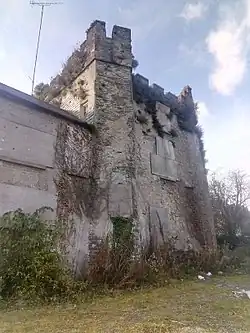Saint David's Castle
Saint David's Castle is a 13th-century Norman castle located in Naas, Ireland.[1][2][3]
| Saint David's Castle | |
|---|---|
| Native name Irish: Caisleán Naomh Dáithí | |
 View of castle from the east; its poor state of repair and boarded-up windows are evident. | |
| Type | Fortified house |
| Location | Church Lane, Naas, County Kildare, Ireland |
| Coordinates | 53.217957°N 6.662059°W |
| Height | 12 m (39 ft) |
| Built | 1210 |
 Location of Saint David's Castle in Ireland | |
Location
Saint David's Castle is located just off Church Lane, immediately east of St David's Church.[4]
History
St. David’s Castle, sometimes called King John’s Castle, dates from the early Hiberno-Norman era, perhaps as early as 1200. John visited Naas in 1206. He visited again in 1210, when he held a form of Parliament in the town. About this time County Kildare became a separate county.
The name derives from Saint David, patron saint of Wales, as the Normans who settled Naas were mostly Welsh in origin.
In 1409 Henry IV, Lord of Ireland granted to Naas its first charter as a Corporation and a few years later it was given power to collect tolls at all the entrances to the town, the moneys to go towards fortifying the town with walls and gates.
Saint David's Castle was rebuilt and incorporated into the town wall structure at this time.[5]
It was converted into a dwelling in the 18th century. The Church of Ireland rector occupied the house by the 18th century.[6]
Building
It is a large building of three storeys, comprising a tower with a winding stone staircase.
It is on an irregular plan incorporating the fabric of the tower house, comprising three-bay two-storey range, with single-bay two-storey projecting bay to front (southeast) on an L-shaped plan, having a two-bay single-storey bay with half dormer attic at angles to northeast.[7]
References
- Society, County Kildare Archaeological (18 November 1895). "Journal of the Co. Kildare Archaeological Society and Surrounding Districts" – via Google Books.
- "St. Patrick's Church of Ireland Church Additional Images: Buildings of Ireland: National Inventory of Architectural Heritage". www.buildingsofireland.ie.
- "Ancient Naas castle is "falling down"".
- "St. David's Castle – Kildare Local History . ie". kildarelocalhistory.ie.
- "Archived copy" (PDF). Archived from the original (PDF) on 15 November 2017. Retrieved 18 November 2017.
{{cite web}}: CS1 maint: archived copy as title (link) - Archdall, Mervyn (18 November 1876). Monasticon Hibernicum: Or, A History of the Abbeys, Priories, and Other Religious Houses in Ireland; Interspersed with Memoirs of Their Several Founders and Benefactors, and of Their Abbots and Other Superiors, to the Time of Their Final Suppression. W. B. Kelly. p. 285 – via Internet Archive.
David's Castle.
- "1210 - St. David's Castle, Naas, Co. Kildare - Architecture of Kildare - Archiseek - Irish Architecture". 26 November 2011.